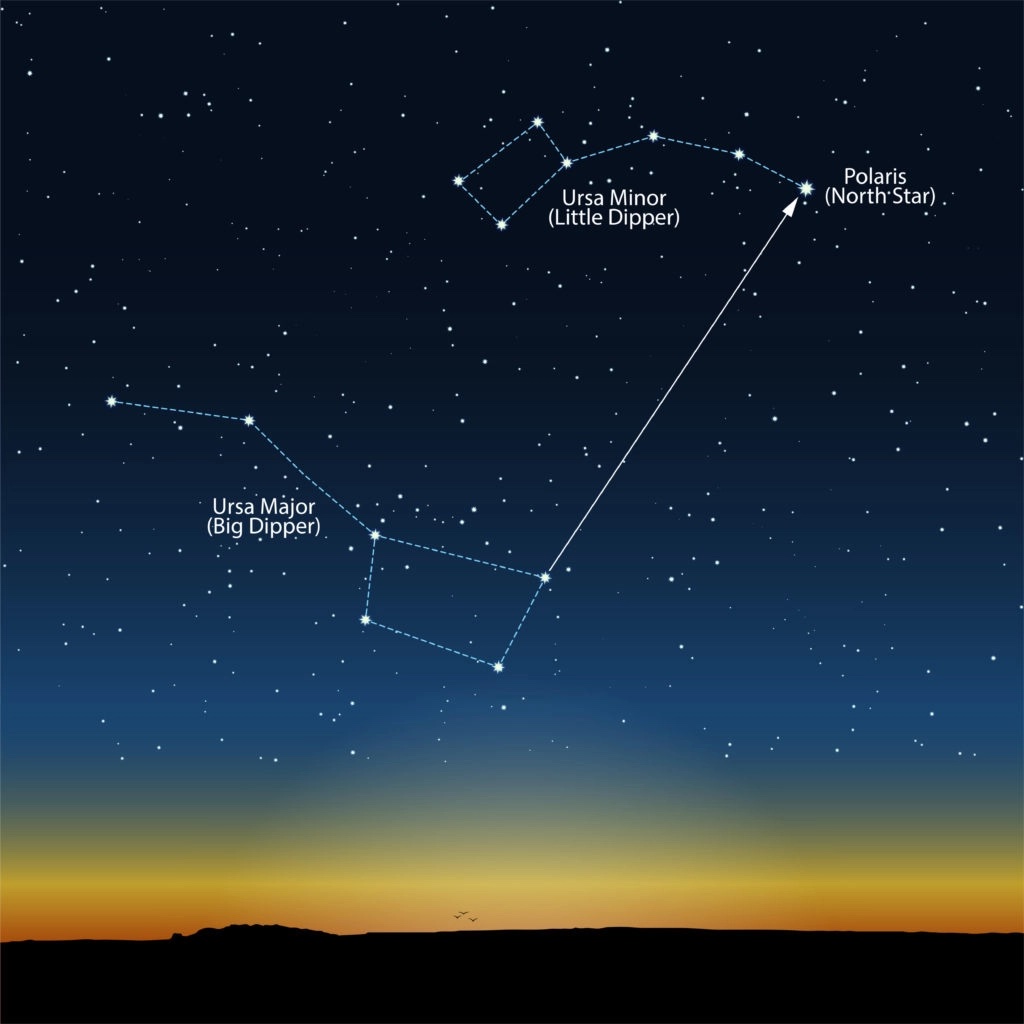Discover the Fascinating Quest for Polaris and its Significance in the World of Astronomy
In the vast expanse of the night sky, where stars twinkle and galaxies sprawl, one constant presence has guided explorers, sailors, and astronomers for centuries—the North Star, also known as Polaris. This unassuming celestial beacon has been a pivotal reference point for navigation and astronomical observations, holding a special place in the annals of human exploration and understanding of the cosmos.
The North Star and Its Importance in Astronomy
The North Star, or Polaris, occupies a unique position in our celestial sphere. It is not only a bright and easily identifiable star, but its fixed location makes it an invaluable tool for astronomers and stargazers alike. In this article, we will delve into the intriguing journey of finding the North Star and explore why it is crucial for the field of astronomy.
Navigating by the Stars: A Historical Perspective
Before the advent of GPS and modern navigation technology, ancient mariners and travelers relied heavily on celestial objects for orientation. Among these celestial objects, Polaris, located within the constellation Ursa Minor, played a pivotal role. Its relative proximity to the North Celestial Pole made it an ideal reference point for determining direction, particularly in the northern hemisphere.
The ancient Greeks, Phoenicians, and Vikings, among others, understood the significance of Polaris in navigation. They used it to guide their ships, ensuring they stayed on course during long and perilous journeys. Even the famous explorers of the Age of Discovery, such as Christopher Columbus and Ferdinand Magellan, depended on Polaris as they ventured into uncharted waters.
Polaris: The North Star’s Unique Position
One of the remarkable features of Polaris is its apparent immobility in the night sky. While other stars and celestial objects appear to move throughout the night due to the Earth’s rotation, Polaris remains relatively fixed. This stability arises from its alignment with the Earth’s axis, which points directly towards the North Celestial Pole. As a result, Polaris becomes a dependable reference point for astronomers and navigators alike.
Locating Polaris in the Night Sky
To embark on the journey of finding the North Star, you don’t need sophisticated equipment or an advanced understanding of astronomy. Polaris is relatively easy to locate using basic observational skills and a few reference points.
Step 1: Find the Big Dipper
The first step in finding Polaris involves identifying the Big Dipper, also known as the Plough or Ursa Major. This prominent asterism consists of seven bright stars and resembles a ladle or saucepan.
Step 2: Follow the Pointer Stars
Once you’ve located the Big Dipper, focus on the two stars at the outer edge of the ladle, which are often referred to as the “Pointer Stars.” These stars, Merak and Dubhe, point towards Polaris.

Step 3: Extend the Line
Now, extend an imaginary line formed by the Pointer Stars outwards, away from the Big Dipper. If you continue along this line for approximately five times the distance between Merak and Dubhe, you will arrive at Polaris.

Why Polaris Matters in Astronomy
Beyond its utility in navigation, Polaris holds great significance in the realm of astronomy. Its fixed position relative to the Earth’s axis has several practical applications in this field:
1. Finding True North
Polaris provides a reliable reference point for determining true north, aiding astronomers in setting up telescopes and aligning them with precision. This is crucial for capturing accurate observations of celestial objects.
2. Astrophotography and Time-Lapse Imaging
For astrophotographers and those interested in time-lapse imaging of the night sky, Polaris serves as an anchor point. By tracking the apparent movement of stars around Polaris, photographers can create stunning images of the cosmos.
3. Star Hopping
Astronomers often use a technique known as “star hopping” to locate distant celestial objects. By identifying Polaris first, they can then navigate to other regions of the sky with greater ease, making their observations more efficient.
4. Celestial Coordinates
Polaris plays a pivotal role in defining celestial coordinates. Its position is used as the reference point for celestial navigation, akin to the Prime Meridian’s role in terrestrial longitude and latitude.
Beyond Polaris: Other Celestial Navigational Aids
While Polaris is undoubtedly a crucial reference point, it is not the only celestial object used for navigation and astronomical observations. Here are a few other celestial aids that have played vital roles throughout history:
The Sun
The sun, our closest star, has been a primary source of direction for centuries. During the day, travelers and sailors have used the sun’s position in the sky to determine cardinal directions.
The Moon
The moon’s position and phases have also been valuable for navigation. Sailors, in particular, used lunar observations to calculate their longitude at sea.
Planets
Certain planets, such as Venus and Jupiter, are often bright and visible in the night sky. They have served as navigational aids and points of interest for astronomers.
Constellations
Aside from Polaris, various constellations and stars have aided navigation and provided inspiration for mythologies and cultures worldwide. The Southern Cross, for instance, is a prominent feature in the southern hemisphere sky.
Modern Tools and Technology
As technology has advanced, traditional methods of celestial navigation have given way to more precise and automated systems. GPS (Global Positioning System) has revolutionized navigation, rendering the use of stars like Polaris less essential for everyday travel.
However, in the realm of astronomy, Polaris continues to be a valuable reference point, especially for amateur astronomers and astrophotographers who seek to capture the beauty of the night sky. Moreover, Polaris serves as a connection to the rich history of human exploration and discovery.
Polaris in Mythology and Culture
Throughout history, Polaris has held a place of prominence in the myths and legends of various cultures. Its stationary position in the night sky made it a symbol of stability and guidance.
Norse Mythology: The Lodestar
In Norse mythology, Polaris was often referred to as the “Lodestar” or “Pole Star.” Vikings and Norse explorers believed that this star guided them safely on their journeys, even in the most treacherous conditions.
Ancient Greece: The Guardian of the Celestial Axis
In ancient Greek mythology, the constellation Ursa Minor, which contains Polaris, was associated with the story of Callisto, a nymph turned into a bear. Ursa Minor was believed to be the guardian of the celestial axis, with Polaris at its center.
Native American Cultures: The North Star’s Wisdom
Various Native American tribes also held Polaris in high regard. It was seen as a wise and constant presence in the night sky, guiding people on their spiritual and physical journeys.
Polaris in Modern Culture
The significance of Polaris extends to modern culture as well. It is often used symbolically in literature, music, and art to represent guidance, stability, and aspirations. In the famous novel “Moby-Dick” by Herman Melville, Captain Ahab’s quest for the white whale is compared to the unchanging nature of Polaris in the starry sky.
Observing Polaris with Telescopes
For amateur astronomers and stargazers, Polaris is not only a guide but also a fascinating celestial object to observe through telescopes. Despite its apparent brightness, Polaris is a multiple star system, revealing hidden complexities when viewed up close.
Stellar Characteristics
Polaris is a binary star system consisting of a bright primary star, Polaris A, and a smaller companion, Polaris Ab. Additionally, there is a distant companion, Polaris B, which orbits the primary pair. These characteristics make Polaris a captivating target for astronomers interested in binary star systems.
Variable Star
One of the most intriguing aspects of Polaris is its variability. It is classified as a Cepheid variable star, meaning its brightness varies over a predictable period. This variability has been crucial in the field of astronomy, as it allows astronomers to determine the distances to other galaxies and stars by comparing their apparent brightness to that of Polaris.
Polaris, The North Star
In the realms of both navigation and astronomy, Polaris remains a steadfast companion to explorers of the night sky. Its historical significance as a guiding star for sailors and travelers is matched by its enduring importance in the field of astronomy. Whether you are an amateur astronomer or simply a curious observer, finding the North Star, Polaris, is a rewarding journey that connects us to our celestial heritage and the wonders of the cosmos.
Throughout history and across cultures, Polaris has symbolized guidance, constancy, and the human spirit of exploration. As we continue to unravel the mysteries of the universe, let Polaris remind us of the unchanging beauty that lies beyond our earthly horizons.

